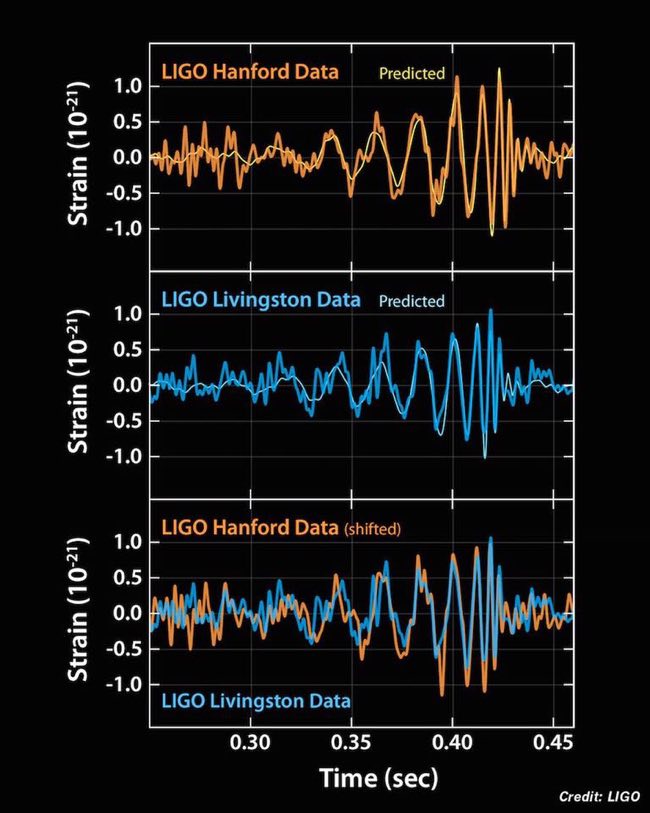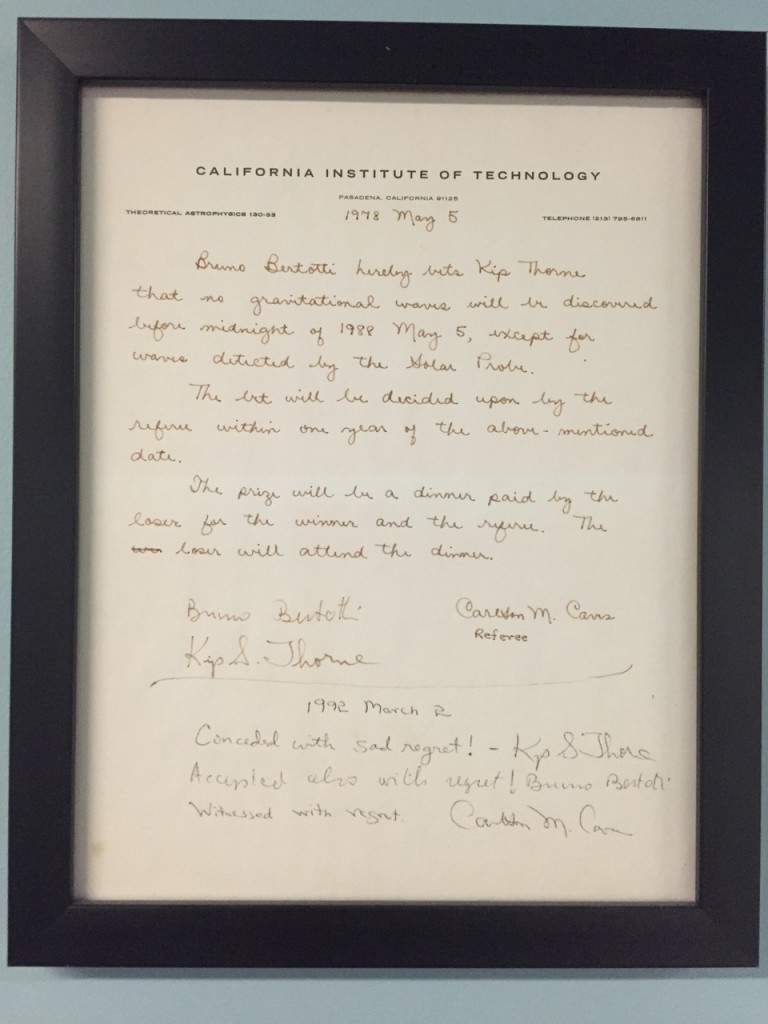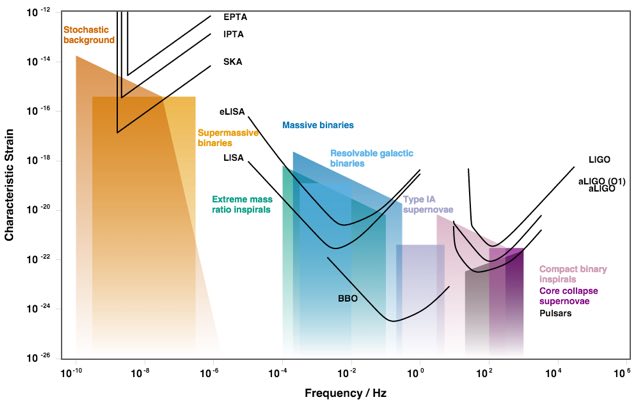ONCE upon a time, there lived a man who was fascinated by the phenomenon of gravity. In his mind he imagined experiments in rocket ships and elevators, eventually concluding that gravity isn’t a conventional “force” at all — it’s a manifestation of the curvature of spacetime. He threw himself into the study of differential geometry, the abstruse mathematics of arbitrarily curved manifolds. At the end of his investigations he had a new way of thinking about space and time, culminating in a marvelous equation that quantified how gravity responds to matter and energy in the universe.
Not being one to rest on his laurels, this man worked out a number of consequences of his new theory. One was that changes in gravity didn’t spread instantly throughout the universe; they traveled at the speed of light, in the form of gravitational waves. In later years he would change his mind about this prediction, only to later change it back. Eventually more and more scientists became convinced that this prediction was valid, and worth testing. They launched a spectacularly ambitious program to build a technological marvel of an observatory that would be sensitive to the faint traces left by a passing gravitational wave. Eventually, a century after the prediction was made — a press conference was called.
Chances are that everyone reading this blog post has heard that LIGO, the Laser Interferometric Gravitational-Wave Observatory, officially announced the first direct detection of gravitational waves. Two black holes, caught in a close orbit, gradually lost energy and spiraled toward each other as they emitted gravitational waves, which zipped through space at the speed of light before eventually being detected by our observatories here on Earth. Plenty of other places will give you details on this specific discovery, or tutorials on the nature of gravitational waves, including in user-friendly comic/video form.
What I want to do here is to make sure, in case there was any danger, that nobody loses sight of the extraordinary magnitude of what has been accomplished here. We’ve become a bit blasé about such things: physics makes a prediction, it comes true, yay. But we shouldn’t take it for granted; successes like this reveal something profound about the core nature of reality.
Some guy scribbles down some symbols in an esoteric mixture of Latin, Greek, and mathematical notation. Scribbles originating in his tiny, squishy human brain. (Here are what some of those those scribbles look like, in my own incredibly sloppy handwriting.) Other people (notably Rainer Weiss, Ronald Drever, and Kip Thorne), on the basis of taking those scribbles extremely seriously, launch a plan to spend hundreds of millions of dollars over the course of decades. They concoct an audacious scheme to shoot laser beams at mirrors to look for modulated displacements of less than a millionth of a billionth of a centimeter — smaller than the diameter of an atomic nucleus. Meanwhile other people looked at the sky and tried to figure out what kind of signals they might be able to see, for example from the death spiral of black holes a billion light-years away. You know, black holes: universal regions of death where, again according to elaborate theoretical calculations, the curvature of spacetime has become so pronounced that anything entering can never possibly escape. And still other people built the lasers and the mirrors and the kilometers-long evacuated tubes and the interferometers and the electronics and the hydraulic actuators and so much more, all because they believed in those equations. And then they ran LIGO (and other related observatories) for several years, then took it apart and upgraded to Advanced LIGO, finally reaching a sensitivity where you would expect to see real gravitational waves if all that fancy theorizing was on the right track.
And there they were. On the frikkin’ money.
Our universe is mind-bogglingly vast, complex, and subtle. It is also fantastically, indisputably knowable.

I got a hard time a few years ago for predicting that we would detect gravitational waves within five years. And indeed, the track record of such predictions has been somewhat spotty. Outside Kip Thorne’s office you can find this record of a lost bet — after he predicted that we would see them before 1988. (!)
But this time around I was pretty confident. The existence of overly-optimistic predictions in the past doesn’t invalidate the much-better predictions we can make with vastly updated knowledge. Advanced LIGO represents the first time when we would have been more surprised not to see gravitational waves than to have seen them. And I believed in those equations.
I don’t want to be complacent about it, however. The fact that Einstein’s prediction has turned out to be right is an enormously strong testimony to the power of science in general, and physics in particular, to describe our natural world. Einstein didn’t know about black holes; he didn’t even know about lasers, although it was his work that laid the theoretical foundations for both ideas. He was working at a level of abstraction that reached as far as he could (at the time) to the fundamental basis of things, how our universe works at the deepest of levels. And his theoretical insights were sufficiently powerful and predictive that we could be confident in testing them a century later. This seemingly effortless insight that physics gives us into the behavior of the universe far away and under utterly unfamiliar conditions should never cease to be a source of wonder.
We’re nowhere near done yet, of course. We have never observed the universe in gravitational waves before, so we can’t tell for sure what we will see, but plausible estimates predict between one-half and several hundred events per year. Hopefully, the success of LIGO will invigorate interest in other ways of looking for gravitational waves, including at very different wavelengths. Here’s a plot focusing on three regimes: LIGO and its cousins on the right, the proposed space-based observatory LISA in the middle, and pulsar-timing arrays (using neutron stars throughout the galaxy as a giant gravitational-wave detector) on the left. Colorful boxes are predicted sources; solid lines are the sensitivities of different experiments. Gravitational-wave astrophysics has just begun; asking us what we will find is like walking up to Galileo and asking him what else you could discover with telescopes other than moons around Jupiter.
For me, the decade of the 2010’s opened with five big targets in particle physics/gravitation/cosmology:
- Discover the Higgs boson.
- Directly detect gravitational waves.
- Directly observe dark matter.
- Find evidence of inflation (e.g. tensor modes) in the CMB.
- Discover a particle not in the Standard Model.
The decade is about half over, and we’ve done two of them! Keep up the good work, observers and experimentalists, and the 2010’s will go down as a truly historic decade in physics.



Here is a link to arguments that this finding along with a host of other do not support the idea of gravity waves. I am not a physicist but thought i would post it for comment:
https://m.facebook.com/story.php?story_fbid=727562184047013&id=100003797130404
@Jeff H: Good observation. By cross-correlating the signal+noise at one site against the signal+noise at other site, it would be possible to detect the presence of a common signal at the two sites (assuming the “noises” are independent). Perhaps this is the way the presence of the signal was initially detected, then they set about running their theoretical models with different assumptions about the sizes of the two black holes (and other parameters?) to get the best possible match between the theoretical signal and the observed (noisy) signals. I wonder if this is how the analysis worked? I also wonder how they decided the black holes were ~1 billion light-years distant?
“Here is a link to arguments that this finding along with a host of other do not support the idea of gravity waves. I am not a physicist but thought i would post it for comment:”
I can’t decide whether that or the following link is the best it-would-be-funny-if-it-weren’t-so-pathetic gravitational-wave web page:
https://lovegod.wordpress.com/2007/02/19/god-could-be-detected-by-gravitational-waves/
(Don’t get any wrong ideas based on your own concept of “love god”.)
Thanks for the explanations guys, even the half ones, much appreciated.
Thanks a lot for this informative piece! As a non-physicist researcher, I’m wondering about the statements that this opens up new ways of exploring gravity. From what I understood, the event that was measured and used as the proof (the 2 black holes collision) is extremely rare, let alone the ability to detect it. So should we expect future data to be as scarce? i.e. to become detectable and available for analysis every 10-15 years or so?
The proof or discovery of gravitational waves brings up a couple of questions. Since man has proven the existence of these waves does that mean we have also proven the existence of gravitational particles – gravitons? Question 2: Since the measurements is significantly less than the size of a proton how do we know that space indeed shrinks or expands by these waves and is not some quantum fluctuation? At that scale I’m sure quantum fluctuations are indeed present? (Not sure I have the correct terminology, just hope you get the idea).
This is the best description of the results and importance of this finding that I have encountered to date-and it was FUN to read.
Results impossible with instruments according to this commentary:
https://m.facebook.com/story.php?story_fbid=728319700637928&id=100003797130404
I think, in simple terms, electric force and gravitational force are both inverse square laws, which means the interaction bosons have no rest mass. Since light travels at the speed of light, and the graviton operates similarly, it too must travel at the speed of light. This is of course in vacuum.
Sean, you forgot detection of astrophysical high-energy neutrinos.
If the a ether theory was correct, would it look like noise in this experiment? As itis not seen,I guess that this is a very sensitive confirmation of the Michelson Morley result.
@Mark
That guy forgot that the the light inside LIGO is bounced back and forth 400 times. Isn’t it amazing that the thousands of physicists involved with and watching this program did NOT overlook what would have been an utterly obvious and moronic design flaw?
I think that the gravitational waves are generated by the distortions of space time,that altere it’s curvatures geometry and topology.the variation of spacetime as echoes generated by two black holes merged.the important is know to the level of distortions of the produced by the energy of these gravitational waves are the black holes.at start of certain energy level and distortons of the curvatures of space depend of types of curvatures of spacetime
As an experiment, I find this strange. The claim is that the LIGO detection system can correct for known disturbances (seismic, etc.), but there doesn’t seem to be any provision for unknown or otherwise undetectable sources of disturbance. This strikes me as a hubristic argument from ignorance – we don’t know what else this could be, therefore it’s gravitational waves. Also, I don’t really see how this can be seen as corroboration of the claim that black hole mergers cause gravitational waves, because we have no independent evidence that the causal event, a black hole merger, actually occurred. I’m not trying to troll here, and I’m sure there are good answers, but I’m genuinely puzzled that I haven’t seen these questions raised elsewhere.
@Richard, you have missed an important part of how the signal is interpreted. Physicists produced predictions of what sort of signal would be produced by various types of events. The detected signal matches one of the predicted signals almost perfectly.
SOMETHING created an oscillating difference in the lengths of the arms of one detector, and then created the same oscillation 7 milliseconds later in the arms of another detector 3000 km away. That time differential implies that the thing that created the oscillation traveled at light speed. LIGO does not detect EM waves. What else travels at light speed besides light? Gravitational waves.
The assertion that merging black holes create gravitational waves comes from general relativity, which is well-established in many other ways. GR would have to be quite wrong if such a merger did not produce these waves. We’d know it was that wrong if that were the case. The experiment should not be viewed as verification that merging black holes would produce gravitational waves. No one really doubts that. It should be viewed as confirmation of the existence of gravitational waves, and strong (but not iron clad) evidence of the existence of black holes.
Probably if there is a fight about what LIGO means it will be about what exactly the event was that produced the waves, not whether the waves were produced. Perhaps other events that physicists did not think of would also produce the same pattern of gravitational waves that they are currently attributing to the merger of two black holes each with mass of about 30x that of the sun.
@Andrew – No, I am completely familiar with that reasoning. And I don’t doubt the truth of General Relativity or gravitational waves at all. My concern is with the argument that it’s not an EM disturbance, so it must be a gravitational wave. The universe and its workings are not completely known to us.What else travels at the speed of light apart from electromagnetic waves and gravitational waves? Something we don’t know about, maybe. I am not saying this is probable – I just think the degree of certainty expressed in these results seems cocky, given the lack of independent evidence of the causal event
@Richard Moloney
I’m curious. Do you agree that something other than light traveled the speed of light while you are unsure that is was a gravitational wave? For example, you think it might be a gravitational wave while it could be something else that physicists never considered?
@Richard
Well, that critique can be applied everywhere in science, right? I mean, we have all this evidence that electrons exist, but it all COULD be explained by something we never thought of. Special relativity fits all the observations but there COULD be another explanation.
If we have a theory that fits the available evidence, and we don’t have another theory, we use the theory we’ve got until something comes along that fits the evidence better. This is how science progresses. Nothing in science is ever proven with certainty.
For further reading on this idea, I like this page very much
http://newt.phys.unsw.edu.au/einsteinlight/jw/module6_other.htm
@James
I’m saying it’s possible. Two hundred years ago, much of the electromagnetic spectrum was imperceptible to us. Who really knows what we can’t perceive right now?
@Andrew
Yeah, science does usually, if only implicitly, say that X is the best theory we have right now (though the level of epistemic humility varies widely with the discipline and scientist). But still, what’s weird to me about this experiment is the complete lack of, not only control over but even corroboration that the causal event actually occurred. Is there any precedent for this in experimental history?
@Richard, I would say yes.
All of our early work in understanding radioactivity was based on emissions from unseen and uncorroborated decay events.
Newton deduced that the planets were attracted by the sun without seeing what happens when the sun is not there.
Rutherford deduced the presence of atomic nuclei without corroborating that a collision had taken place.
Einstein deduced all of special relativity pretty much without any event to look at at all. Same with GR, come to think of it.
No independent detection of a quark has ever been made.
Maxwell deduced that light is an electromagnetic wave without seeing an event that produced the light.
These are just the ones that came to mind easily. I’m sure there are many more, including many outside the field of physics. For example, we deduce a great deal about evolution without having watched the events that caused speciation.
Perhaps a different way to think about it is to redefine what you are considering to be the event. The event was “gravitational waves disturbed our gravitational wave detector”. Do we have to know where they originated to know that they are gravitational waves? Well, do we have to know where light waves originated to know that they are light waves? No. We recognize them by the effect they have when they reach us.
Sean
Has this validation caused you to change your view of General Relativity limitations?
Sean,
Amazing achievement, I guess you’ll have to update “The Big Picture” already?
Just wild imagination: Will our ability to detect Gravitational Waves someday enable us to “see” (detect) other universes? And if so, under what circumstances? At their “big bang” creation out of “nothing” à la Krauss? Or due to some event in that “other” universe?
Is there a cosmological redshift experienced by gravitational waves?
The wave equation for gravitational waves looks like a scalar wave equations, so doppler shifting
and all of that should apply. It seems that it would make the calculation of the distance to
the source more difficult.
Dear Sean,
If displacements are 10⁻¹⁸m, and thus smaller than an atom, how was the vibration of the atoms conforming the mirrors taken into account? I haven’t been able to find more information on the noise treatment of this issue.
Thanks!